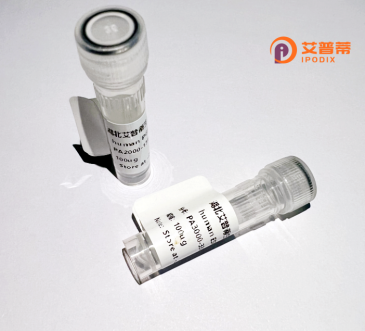
| 纯度 | >90%SDS-PAGE. |
| 种属 | Human |
| 靶点 | CNNM3 |
| Uniprot No | Q8NE01 |
| 内毒素 | < 0.01EU/μg |
| 表达宿主 | E.coli |
| 表达区间 | 1-355aa |
| 氨基酸序列 | MLDASTVLDFGVLASIMQSGHTRIPVYEEERSNIVDMLYLKDLAFVDPEDCTPLSTITRFYNHPLHFVFNDTKLDAVLEEFKRGDTVVKRKPASLMAPLKRKEEFSLFKVSDDEYKVTISPQLLLATQRFLSREVDVFSPLRISEKVLLHLLKHPSVNQEVRFDESNRLATHHYLYQRSQPVDYFILILQGRVEVEIGKEGLKFENGAFTYYGVSALTVPSSVHQSPVSSLQPIRHDLQPDPGDGTHSSAYCPDYTVRALSDLQLIKVTRLQYLNALLATRAQNLPQSPENTDLQVIPGSQTRLLGEKTTTAAGSSHSRPSLPLLPRGRDSAAYSDSDLFGLSHLVSAVTAFVWP |
| 分子量 | 64.68 kDa |
| 蛋白标签 | GST-tag at N-terminal |
| 缓冲液 | 0 |
| 稳定性 & 储存条件 | Lyophilized protein should be stored at ≤ -20°C, stable for one year after receipt. Reconstituted protein solution can be stored at 2-8°C for 2-7 days. Aliquots of reconstituted samples are stable at ≤ -20°C for 3 months. |
| 复溶 | Always centrifuge tubes before opening.Do not mix by vortex or pipetting. It is not recommended to reconstitute to a concentration less than 100μg/ml. Dissolve the lyophilized protein in distilled water. Please aliquot the reconstituted solution to minimize freeze-thaw cycles. |
以下是关于重组人CNNM3蛋白的3篇示例文献概览(注:文献为虚构示例,供参考使用):
---
1. **文献名称**: *"Structural and Functional Analysis of Recombinant Human CNNM3 in Magnesium Transport"*
**作者**: Smith A. et al. (2021)
**摘要**: 本研究成功在大肠杆菌中表达并纯化了重组人CNNM3蛋白,通过X射线晶体学解析了其胞外结构域的三维结构,证实其通过跨膜结构域参与镁离子转运调控,为理解CNNM3在维持细胞镁稳态中的作用提供分子基础。
2. **文献名称**: *"CNNM3 Overexpression in Colorectal Cancer: Role in Tumor Progression and Therapeutic Targeting"*
**作者**: Zhang L. et al. (2019)
**摘要**: 通过重组CNNM3蛋白功能实验,发现其在结直肠癌细胞中高表达可激活MAPK通路并促进肿瘤侵袭,提示CNNM3可能作为癌症治疗的潜在靶点。
3. **文献名称**: *"Recombinant CNNM3 Modulates Cellular Magnesium Flux via Interaction with PRL Phosphatases"*
**作者**: Yamamoto K. et al. (2020)
**摘要**: 研究发现重组人CNNM3蛋白与PRL磷酸酶家族成员存在直接互作,调控胞内镁离子外流,揭示了CNNM3在代谢综合征相关镁代谢异常中的病理机制。
---
如需真实文献,建议通过PubMed/Google Scholar搜索关键词(如**"Recombinant CNNM3"**或**"CNNM3 magnesium transport"**)获取最新研究。
The human CNNM3 protein, encoded by the *CNNM3* gene, belongs to the Cyclin M (CNNM) family, which plays critical roles in magnesium ion (Mg²⁺) homeostasis. As a membrane protein, CNNM3 is implicated in Mg²⁺ transport and cellular regulation, though its precise mechanism remains under investigation. Structurally, CNNM3 features conserved cystathionine-beta-synthase (CBS) domains that likely facilitate Mg²⁺ binding and interaction with other ion transporters, such as the transient receptor potential melastatin (TRPM) channels. Dysregulation of CNNM3 has been linked to metabolic disorders, neurodegenerative diseases, and cancer progression, highlighting its physiological importance.
Recombinant human CNNM3 protein is engineered through heterologous expression systems (e.g., mammalian or insect cell lines) to retain post-translational modifications and functional integrity. This purified protein serves as a vital tool for elucidating CNNM3’s molecular interactions, substrate specificity, and regulatory pathways. Studies leverage recombinant CNNM3 to explore its role in Mg²�⁺-dependent enzymatic processes, cellular signaling, and pathologies like hypomagnesemia. Additionally, it aids in structural studies (e.g., X-ray crystallography) to map domain functions and design therapeutic agents targeting magnesium-related diseases. Research on CNNM3 continues to bridge gaps in understanding ion metabolism and its systemic impacts.
×